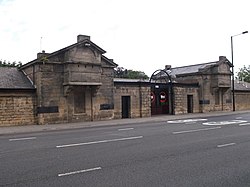| Fenham Barracks | |
|---|---|
| Newcastle upon Tyne | |
 Former guard houses and entrance of Fenham Barracks | |
| Site information | |
| Type | Barracks |
| Owner | Ministry of Defence |
| Operator | |
| Location | |
| Coordinates | 54°58′47″N01°37′53″W / 54.97972°N 1.63139°W |
| Site history | |
| Built | 1804–1806 |
| Built for | War Office |
| In use | 1806–Present |
| Garrison information | |
| Occupants | D Squadron and Regimental Headquarters Queen's Own Yeomanry 201 Hospital Squadron, 214 (NE) MMR |
Fenham Barracks is an Army Reserve installation on Barrack Road, Newcastle upon Tyne, Tyne and Wear, England.


